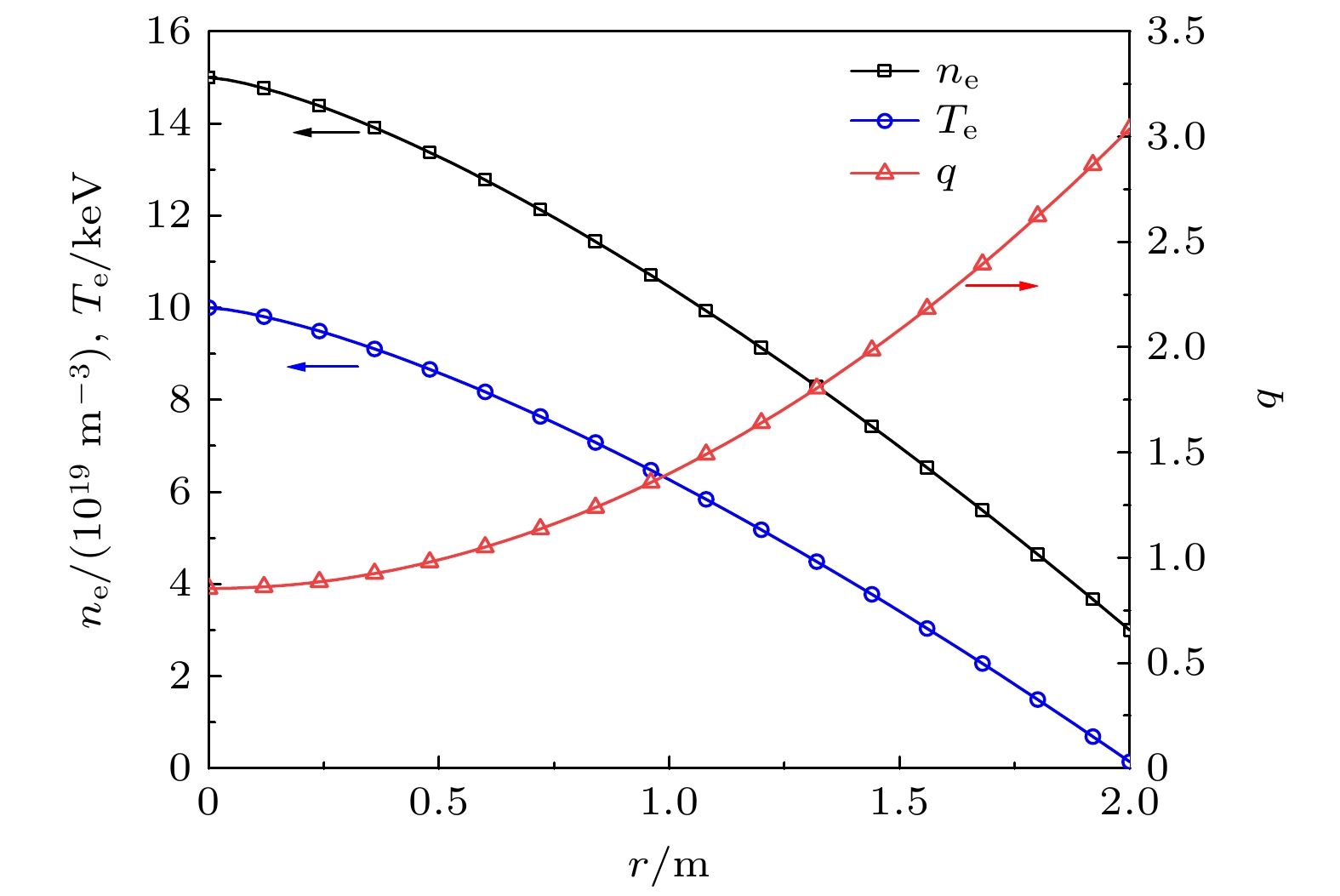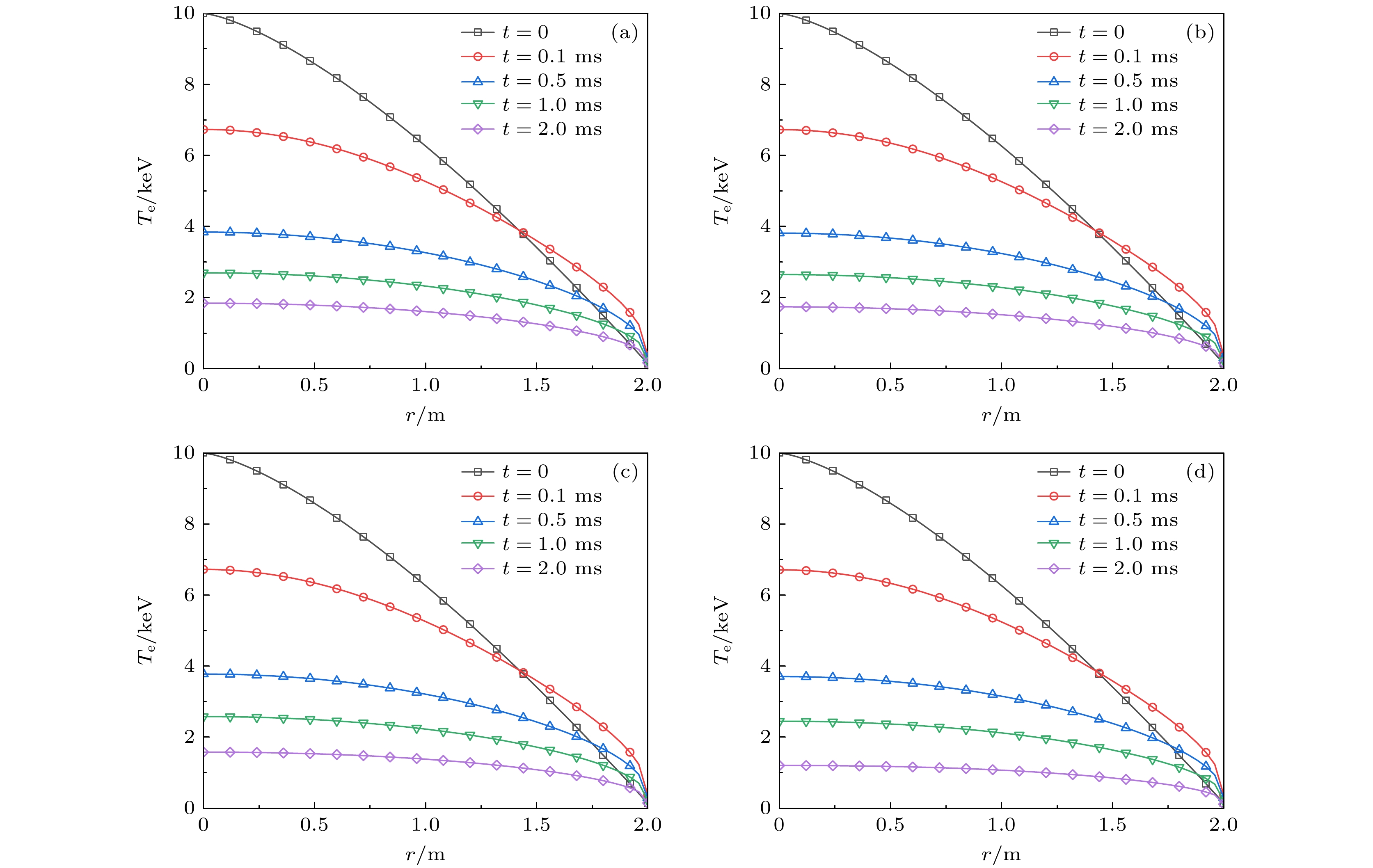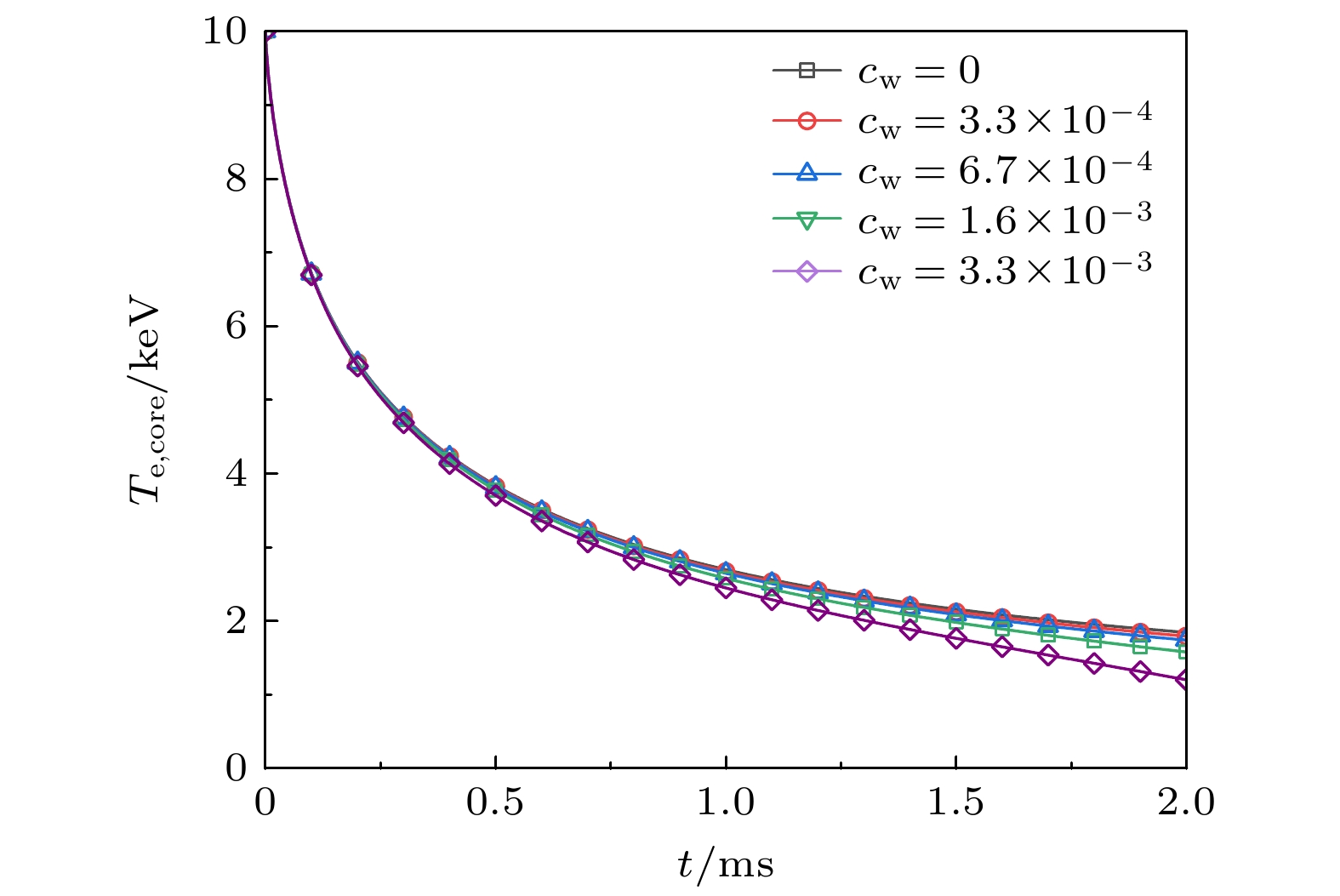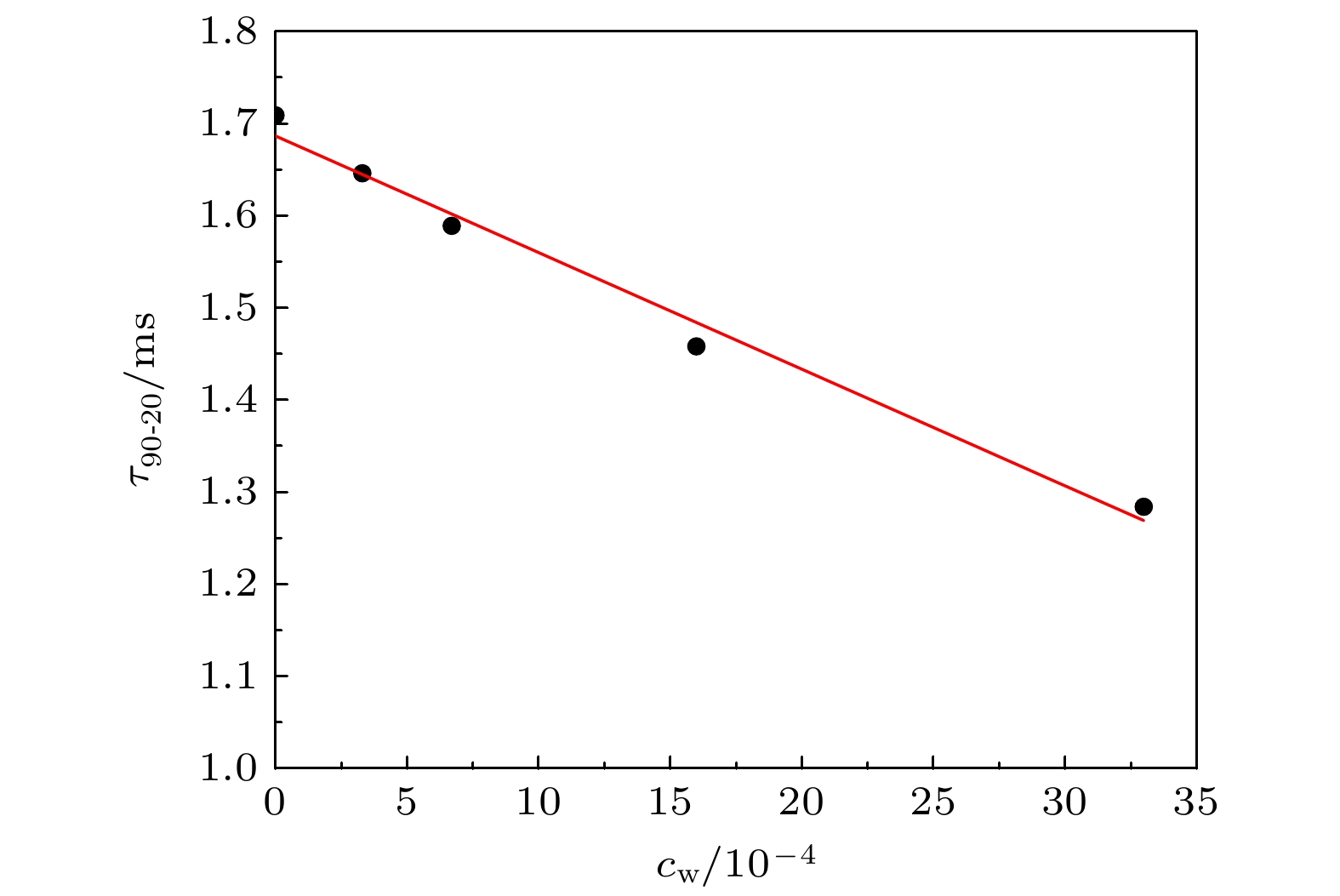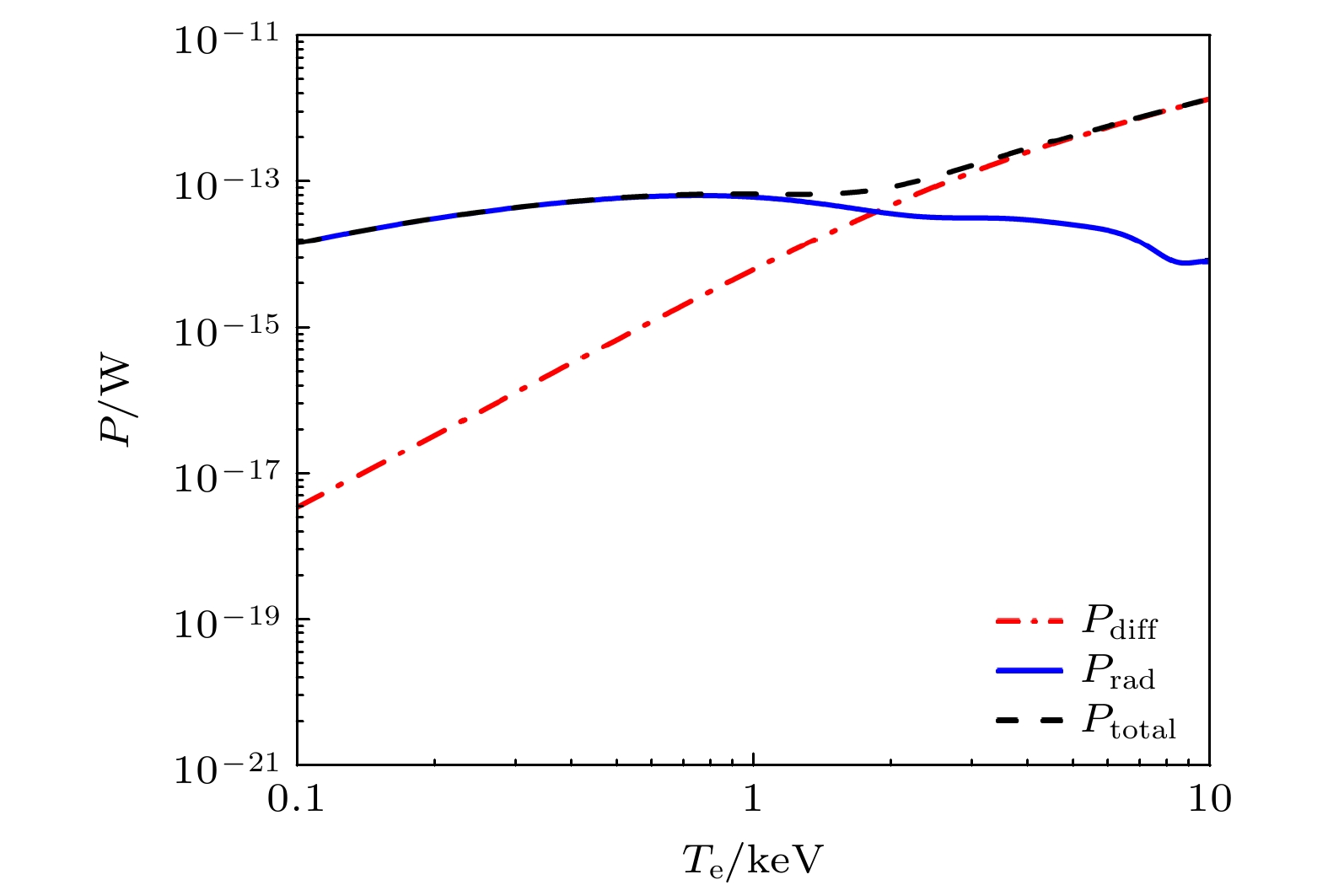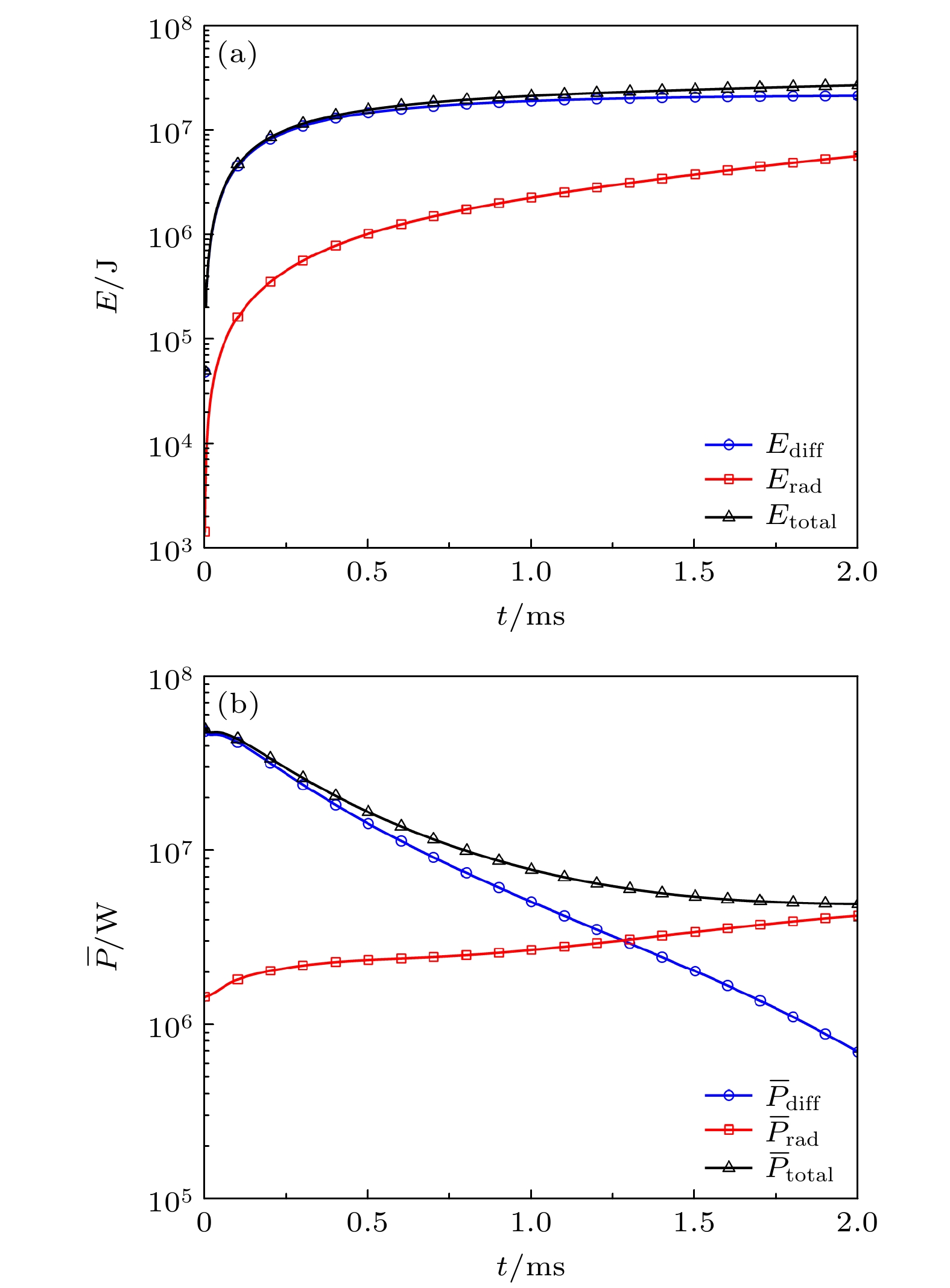-
Recent studies based on the PLT, EAST, WEST, ASDEX-upgrade, JET and other tokamaks have shown that the accumulation of heavy impurities in the core regime is unavoidable, which may lead to the degradation of the plasma confinement and even trigger the major disruptions. The plasma thermal energy loss during the major disruptions mainly occurs during the fast thermal quench (TQ) stage. However, there is no comprehensive physical explanation for the scaling of the timescale of this stage. Tungsten as high Z impurity, which will be used as the wall material in International Thermonuclear Experimental Reactor (ITER), has strong radiation power, and may affect the thermal energy loss during the fast TQ. This work considers both the thermal diffusion induced by the stochastic magnetic fields and the radiation from tungsten impurities as the dominant thermal loss mechanisms in this stage, and construct a one-dimensional model of electron temperature evolution in tokamak plasmas. We numerically calculate and analyze the evolution of the electron temperature in this stage with the typical ITER-like parameters, and here are our main conclusions: 1) The order of magnitude of the fast TQ timescale is mainly determined by the level of thermal diffusion. However, the radiation from tungsten impurities can quantitively influence on the timescale of fast TQ and the electron temperature in the late phase of fast TQ. The higher the tungsten concentration, the shorter the TQ timescale and the lower the electron temperature it will lead to in the late phase. Both the numerical and analytical results show that the timescale is approximately linear with the tungsten impurity concentration. 2) Based on the evolution of the global energy loss and the global power loss during the fast TQ, it can be found that the global thermal energy loss via the radiation from tungsten impurities is much smaller than that via the thermal diffusion induced by the stochastic magnetic fields during the early phase of fast TQ stage. However, in the late phase of fast TQ stage, the global radiation power can be comparable to or even greater than that of the global thermal diffusion power. This is also the reason why the electron temperature in the late phase of fast TQ decreases as the concentration of tungsten impurities increases. Therefore, the contribution of the radiation from tungsten impurities to the thermal loss cannot be ignored in the late phase of fast TQ.
-
Keywords:
- tokamak /
- major disruption /
- thermal quench /
- tungsten impurity radiation /
- evolution of the electron temperature /
- thermal energy loss
[1] Greenwald M, Terry J L, Wolfe S M, Ejima S, Bell M G, Kaye S M, Neilson G H 1988 Nucl. Fusion 28 2199
 Google Scholar
Google Scholar
[2] Troyon F, Gruber R, Sauremann H, Semenzato S, Succi S 1984 Plasma Phys. Control. Fusion 26 209
 Google Scholar
Google Scholar
[3] Hender T C, Wesley J C, Bialek J, et al. 2007 Nucl. Fusion 47 S128
 Google Scholar
Google Scholar
[4] ITER Physics Expert Group On Disruptions, Plasma Control, MHD, ITER Physics Basis Editors 1999 Nucl. Fusion 39 02251
 Google Scholar
Google Scholar
[5] Strait E J, Lao L L, Luxon J L, Reis E E 1991 Nucl. Fusion 31 527
 Google Scholar
Google Scholar
[6] Gill R D 1993 Nucl. Fusion 33 1613
 Google Scholar
Google Scholar
[7] Xia W, Zeng L, Tang T, et al. 2023 Plasma Phys. Control. Fusion 65 085011
 Google Scholar
Google Scholar
[8] Riccardo V, Loarte A 2005 Nucl. Fusion 45 1427
 Google Scholar
Google Scholar
[9] Sweeney R, Choi W, Austin M, et al. 2018 Nucl. Fusion 58 056022
 Google Scholar
Google Scholar
[10] Bondeson A, Parker R D, Hugon M, Smeulders P 1991 Nucl. Fusion 31 1695
 Google Scholar
Google Scholar
[11] Sheikh U A, Shiraki D, Sweeney R, et al. 2021 Nucl. Fusion 61 126043
 Google Scholar
Google Scholar
[12] Whyte D G, Jernigan T C, Humphreys D A, et al. 2003 J. Nucl. Mater. 313 1239
 Google Scholar
Google Scholar
[13] Hollmann E M, Jernigan T C, Groth M, et al. 2005 Nucl. Fusion 45 1046
 Google Scholar
Google Scholar
[14] Isler R C 1984 Nucl. Fusion 24 1599
 Google Scholar
Google Scholar
[15] Hinnov E, Mattioli M 1978 Phys. Lett. A 66 109
 Google Scholar
Google Scholar
[16] Wang F Q, Zha X J, Duan Y M, et al. 2018 Plasma Phys. Control. Fusion 60 125005
 Google Scholar
Google Scholar
[17] Yang X, Manas P, Bourdelle C, et al. 2020 Nucl. Fusion 60 086012
 Google Scholar
Google Scholar
[18] Neu R, Dux R, Geier A, et al. 2003 J. Nucl. Mater. 313 116
 Google Scholar
Google Scholar
[19] Köchl F, Loarte A, de la Luna E, et al. 2018 Plasma Phys. Control. Fusion 60 074008
 Google Scholar
Google Scholar
[20] Neu R 2006 Phys. Scr. T123 33
 Google Scholar
Google Scholar
[21] Noda N, Philipps V, Neu R 1997 J. Nucl. Mater. 241 227
 Google Scholar
Google Scholar
[22] Pütterich T, Neu R, Dux R, et al. 2010 Nucl. Fusion 50 025012
 Google Scholar
Google Scholar
[23] Krommes J A, Oberman C, Kleva R G 1983 J. Plasma Phys. 30 11
 Google Scholar
Google Scholar
[24] Xiao S Y, Wang L 2024 Phys. Plasmas 31 042511
 Google Scholar
Google Scholar
[25] Pütterich T, Fable E, Dux R, O'Mullane M, Neu R, Siccinio M 2019 Nucl. Fusion 59 056013
 Google Scholar
Google Scholar
[26] Kallenbach A, Bernert M, Dux R, et al. 2013 Plasma Phys. Control. Fusion 55 124041
 Google Scholar
Google Scholar
[27] Cheng F Y, Shi B R 2007 Chinese Phys. 16 3458
 Google Scholar
Google Scholar
[28] Abdullaev S S, Finken K H, Wongrach K, et al. 2015 J. Plasma Phys. 81 475810501
 Google Scholar
Google Scholar
[29] Militello F, Naulin V, Nielsen A H 2013 Plasma Phys. Control. Fusion 55 074010
 Google Scholar
Google Scholar
[30] Zhu B, Xu X Q, Tang X Z 2023 Nucl. Fusion 63 086027
 Google Scholar
Google Scholar
[31] Shiraki D, Commaux N, Baylor L R, et al. 2015 Nucl. Fusion 55 073029
 Google Scholar
Google Scholar
[32] Lehnen M, Gerasimov S N, Jachmich S, et al. 2015 Nucl. Fusion 55 123027
 Google Scholar
Google Scholar
[33] Tong R H, Chen Z Y, Jiang Z H, et al. 2018 Rev. Sci. Instrum. 89 10E113
 Google Scholar
Google Scholar
-
图 3 对于典型的类ITER参数, 在不同钨浓度下快速TQ阶段不同时刻的电子温度剖面 (a) $ {c_{\text{w}}} = 0 $; (b) $ {c_{\text{w}}} = 6.7 \times {10^{ - 4}} $; (c) $ {c_{\text{w}}} = 1.6 \times {10^{ - 3}} $; (d) $ {c_{\text{w}}} = 3.3 \times {10^{ - 3}} $
Figure 3. Profile of $ {T_{\text{e}}} $ at different times during the fast TQ stage for typical ITER-like parameters with different tungsten concentrations: (a) $ {c_{\text{w}}} = 0 $; (b) $ {c_{\text{w}}} = 6.7 \times {10^{ - 4}} $; (c) $ {c_{\text{w}}} = 1.6 \times {10^{ - 3}} $; (d) $ {c_{\text{w}}} = 3.3 \times {10^{ - 3}} $.
图 4 对于典型的类ITER参数, 钨杂质浓度分别为$ {c_{\text{w}}} = $$ 3.3 \times {10^{ - 4}} $ (红色圆圈), $ {c_{\text{w}}} = 6.7 \times {10^{ - 4}} $ (蓝色三角), $ {c_{\text{w}}} = $$ 1.6 \times {10^{ - 3}} $ (绿色方形), $ {c_{\text{w}}} = 3.3 \times {10^{ - 3}} $ (紫色菱形)和无钨杂质对照组$ {c_{\text{w}}} = 0 $(黑线)的芯部温度$ {T_{{\text{e, core}}}} $演化
Figure 4. Evolution of $ {T_{{\text{e, core}}}} $ with typical ITER-like parameters under $ {c_{\text{w}}} = 3.3 \times {10^{ - 4}} $ (red circles), $ {c_{\text{w}}} = 6.7 \times $$ {10^{ - 4}} $ (blue triangles), $ {c_{\text{w}}} = 1.6 \times {10^{ - 3}} $ (green squares), $ {c_{\text{w}}} = 3.3 \times {10^{ - 3}} $ (purple diamonds) and $ {c_{\text{w}}} = 0 $ (black line), respectively.
图 6 对于典型类ITER参数, 在r/a = 0.5时, 热扩散功率(红色点虚线)、钨杂质辐射功率(蓝色实线)和总损失功率(黑色短划线)随电子温度的演化
Figure 6. Dependence of the thermal diffusive power (red dash-dotted line), the radiation power (blue solid line), and the total power of the thermal loss (black dashed line) on the electron temperature at r/a = 0.5 for typical ITER-like parameters.
图 7 对于典型类ITER参数, 快速TQ 阶段(a)损失的全局总热能(黑色三角)、全局辐射损失能量(红色方形)和全局热扩散损失能量(蓝色圆圈)随时间的演化; (b)全局总损失功率(黑色三角)、全局辐射损失功率(红色方形)和全局扩散损失功率(蓝色圆圈)随时间的演化
Figure 7. For typical ITER-like parameters, (a) the time evolution of the global total thermal energy loss (black triangles), the global energy loss through radiation (red squares) and diffusion (blue circles); (b) the time evolution of the global total power loss (black triangles), the global power loss through radiation (red squares) and diffusion (blue circles) in the tokamak during the fast TQ.
表 1 本工作中用于定量计算电子温度演化的类ITER典型参数
Table 1. Typical ITER-like parameters used in this work to quantify the evolution of electron temperature.
参数
名称大半径
R/m小半径
a/m环向磁场
B/T极向
模数m归一化磁
扰动幅度b参数值 6.2 2 5.3 30 2×10–3 表 2 对于典型的类ITER参数情况, 不同钨杂质浓度下的快速TQ时间尺度$ {\tau _{90 \text{-} 20}} $
Table 2. For the typical ITER-like parameters, the timescale of fast TQ, $ {\tau _{90 \text{-} 20}} $ with different tungsten impurity concentrations.
$ {c_{\text{w}}} $ 0 3.3×10–4 6.7×10–4 1.6×10–3 3.3×10–3 ${\tau _{90 \text{-} 20}}/{\rm ms} $ 1.709 1.646 1.589 1.458 1.284 -
[1] Greenwald M, Terry J L, Wolfe S M, Ejima S, Bell M G, Kaye S M, Neilson G H 1988 Nucl. Fusion 28 2199
 Google Scholar
Google Scholar
[2] Troyon F, Gruber R, Sauremann H, Semenzato S, Succi S 1984 Plasma Phys. Control. Fusion 26 209
 Google Scholar
Google Scholar
[3] Hender T C, Wesley J C, Bialek J, et al. 2007 Nucl. Fusion 47 S128
 Google Scholar
Google Scholar
[4] ITER Physics Expert Group On Disruptions, Plasma Control, MHD, ITER Physics Basis Editors 1999 Nucl. Fusion 39 02251
 Google Scholar
Google Scholar
[5] Strait E J, Lao L L, Luxon J L, Reis E E 1991 Nucl. Fusion 31 527
 Google Scholar
Google Scholar
[6] Gill R D 1993 Nucl. Fusion 33 1613
 Google Scholar
Google Scholar
[7] Xia W, Zeng L, Tang T, et al. 2023 Plasma Phys. Control. Fusion 65 085011
 Google Scholar
Google Scholar
[8] Riccardo V, Loarte A 2005 Nucl. Fusion 45 1427
 Google Scholar
Google Scholar
[9] Sweeney R, Choi W, Austin M, et al. 2018 Nucl. Fusion 58 056022
 Google Scholar
Google Scholar
[10] Bondeson A, Parker R D, Hugon M, Smeulders P 1991 Nucl. Fusion 31 1695
 Google Scholar
Google Scholar
[11] Sheikh U A, Shiraki D, Sweeney R, et al. 2021 Nucl. Fusion 61 126043
 Google Scholar
Google Scholar
[12] Whyte D G, Jernigan T C, Humphreys D A, et al. 2003 J. Nucl. Mater. 313 1239
 Google Scholar
Google Scholar
[13] Hollmann E M, Jernigan T C, Groth M, et al. 2005 Nucl. Fusion 45 1046
 Google Scholar
Google Scholar
[14] Isler R C 1984 Nucl. Fusion 24 1599
 Google Scholar
Google Scholar
[15] Hinnov E, Mattioli M 1978 Phys. Lett. A 66 109
 Google Scholar
Google Scholar
[16] Wang F Q, Zha X J, Duan Y M, et al. 2018 Plasma Phys. Control. Fusion 60 125005
 Google Scholar
Google Scholar
[17] Yang X, Manas P, Bourdelle C, et al. 2020 Nucl. Fusion 60 086012
 Google Scholar
Google Scholar
[18] Neu R, Dux R, Geier A, et al. 2003 J. Nucl. Mater. 313 116
 Google Scholar
Google Scholar
[19] Köchl F, Loarte A, de la Luna E, et al. 2018 Plasma Phys. Control. Fusion 60 074008
 Google Scholar
Google Scholar
[20] Neu R 2006 Phys. Scr. T123 33
 Google Scholar
Google Scholar
[21] Noda N, Philipps V, Neu R 1997 J. Nucl. Mater. 241 227
 Google Scholar
Google Scholar
[22] Pütterich T, Neu R, Dux R, et al. 2010 Nucl. Fusion 50 025012
 Google Scholar
Google Scholar
[23] Krommes J A, Oberman C, Kleva R G 1983 J. Plasma Phys. 30 11
 Google Scholar
Google Scholar
[24] Xiao S Y, Wang L 2024 Phys. Plasmas 31 042511
 Google Scholar
Google Scholar
[25] Pütterich T, Fable E, Dux R, O'Mullane M, Neu R, Siccinio M 2019 Nucl. Fusion 59 056013
 Google Scholar
Google Scholar
[26] Kallenbach A, Bernert M, Dux R, et al. 2013 Plasma Phys. Control. Fusion 55 124041
 Google Scholar
Google Scholar
[27] Cheng F Y, Shi B R 2007 Chinese Phys. 16 3458
 Google Scholar
Google Scholar
[28] Abdullaev S S, Finken K H, Wongrach K, et al. 2015 J. Plasma Phys. 81 475810501
 Google Scholar
Google Scholar
[29] Militello F, Naulin V, Nielsen A H 2013 Plasma Phys. Control. Fusion 55 074010
 Google Scholar
Google Scholar
[30] Zhu B, Xu X Q, Tang X Z 2023 Nucl. Fusion 63 086027
 Google Scholar
Google Scholar
[31] Shiraki D, Commaux N, Baylor L R, et al. 2015 Nucl. Fusion 55 073029
 Google Scholar
Google Scholar
[32] Lehnen M, Gerasimov S N, Jachmich S, et al. 2015 Nucl. Fusion 55 123027
 Google Scholar
Google Scholar
[33] Tong R H, Chen Z Y, Jiang Z H, et al. 2018 Rev. Sci. Instrum. 89 10E113
 Google Scholar
Google Scholar
Catalog
Metrics
- Abstract views: 3162
- PDF Downloads: 71
- Cited By: 0















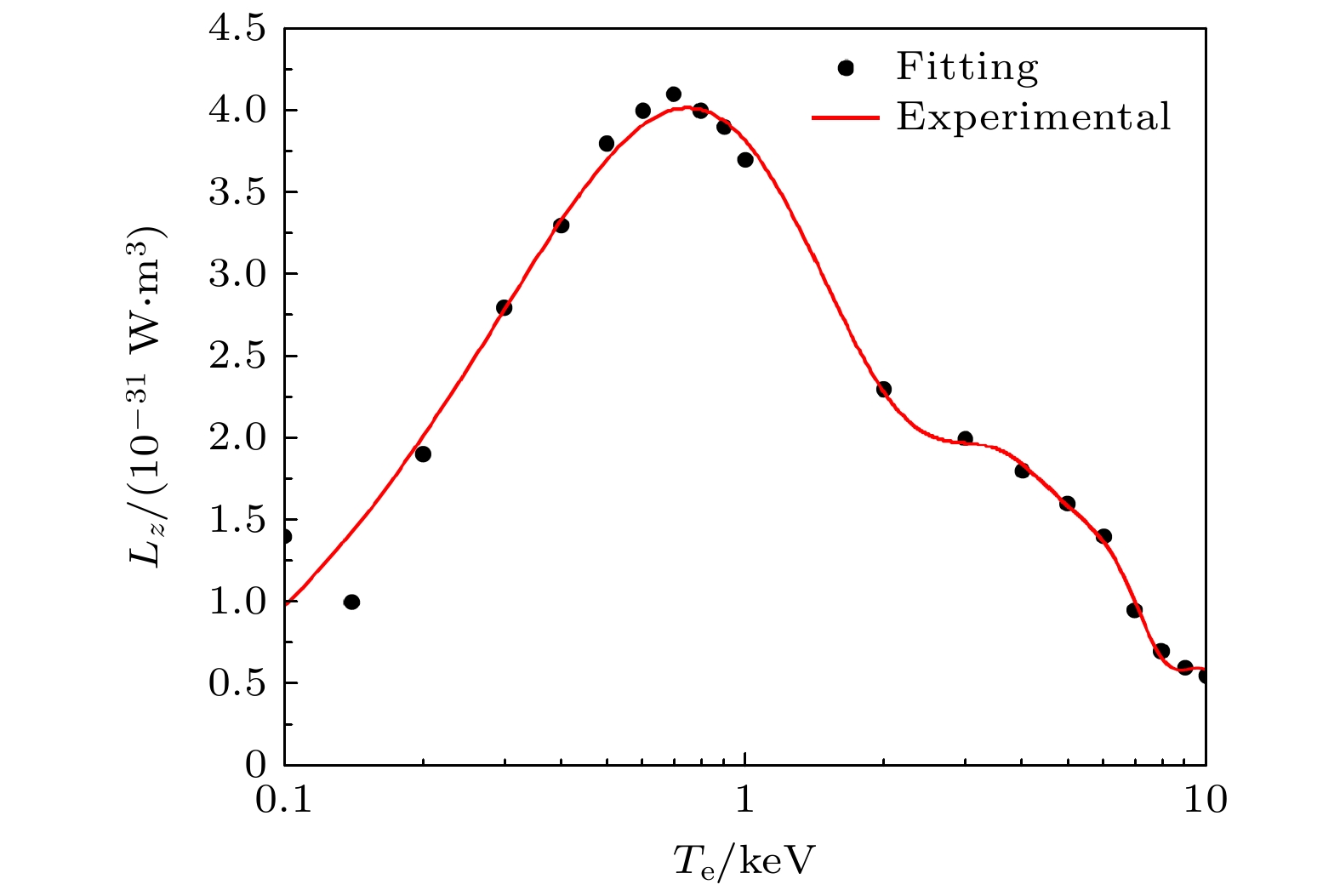
 DownLoad:
DownLoad:
